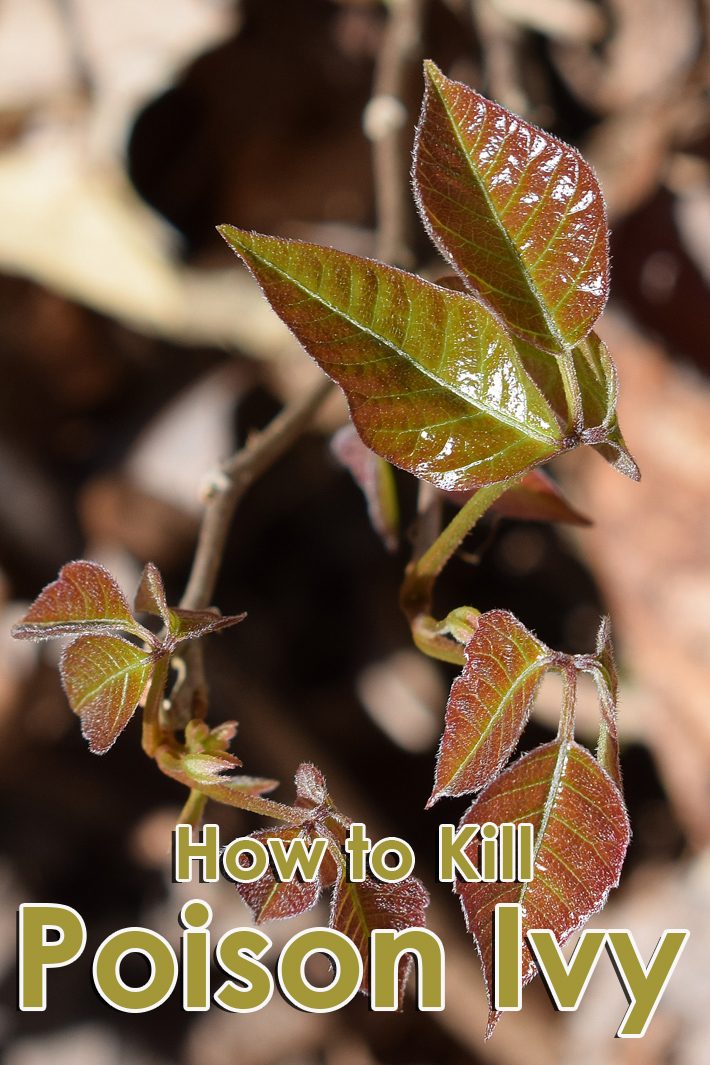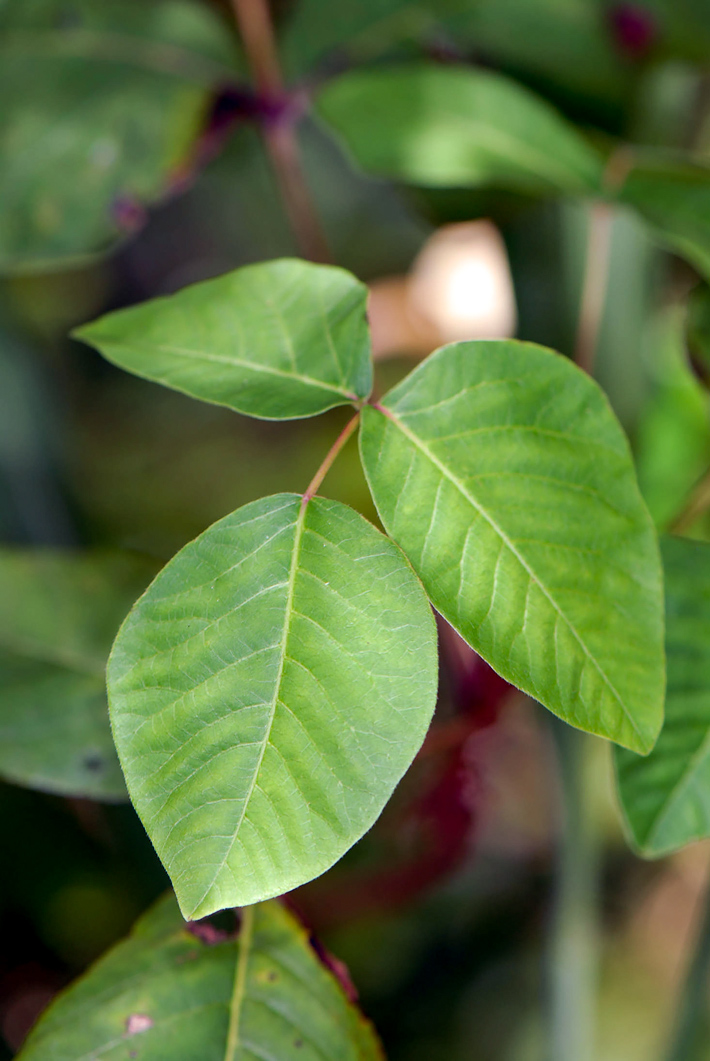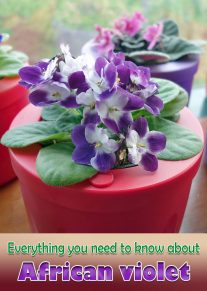
The first step to getting rid of poison ivy is to identify it. Poison ivy is a green (or various shades of red, yellow, or orange in the fall) three-leafed plant that generally grows low to the ground, unless it is climbing a tree or other structure. The leaves may be either toothed or smooth-edged and either shiny or dull, and the middle leaflet is slightly longer than the other two. In spring the plant may have tiny buds or flowers, which become white or grayish berries later in the season.
Poison ivy also can look a lot like poison oak, or like furry raspberry leaves (which you don’t want to kill), and is frequently mistaken for Virginia creeper (which has five-leaf clusters). If you’re not sure if you have poison ivy, put on a pair of heavy gloves and snip off a cluster of leaves to examine closely. Photos abound on the Internet. If you’re still not sure, take the leaves to your local nursery to get a positive ID.
Dealing with poison ivy at home is manageable, but requires vigilance even after treatment. Even after plants have been removed, roots may be overlooked, resulting in the return of the unwanted plant. Try any of these methods for successful eradication, but always wear long sleeve shirts, long pants and gloves when working around poison ivy. Even light contact can end with painful results. No part of the plant is safe to touch!

How to Kill Poison Ivy
You have two choices when it comes to killing poison ivy: a natural method or a chemical poison. Both will work, but chemicals may work faster.
Natural Solutions
If you want to avoid chemicals, you have a few choices:
Manual Labor
Put on long sleeves and pants, tape your pants and shirt cuffs to prevent skin exposure, pull on a pair of heavy gloves, and dig out as much poison ivy as you can. The trick is to get the roots, which means digging down a few inches—at least six—beneath roots and then reaching in to pull them out. This job is easier if the ground is soft; try it after a rainy spell. Be warned that you inevitably will overlook a few little roots. Watch for new growth and pull it out as soon as possible to weaken the plant, or at least to try to break its spirit.
Pulling poison ivy by (gloved) hand is probably the most effective method for removal, but requires direct contact with the plant and extreme care should be taken before disturbing the plants and their roots.
Boiling Water
I am a big fan of pouring a kettle of boiling water onto weeds to kill them. This works best if the plant you want to kill is growing in a crack in a path or next to the driveway or somewhere other than a garden bed full of desirable plants. Boiling water will kill anything it touches. When it comes to poison ivy, the underground roots will survive a dousing. After the boiled leaves and stems die back, new growth will emerge. As soon as you see it, pour on more boiling water. Over time, the rate of new growth will slow.
Smothering
You can cover a patch of poison ivy with a plastic tarp or big piece of cardboard to kill it. Afterward, check the perimeter of the treated area for new growth; underground roots that were outside the jurisdiction of the tarp may send up shoots.
Potions
Make a mixture of 1 cup of salt, 1 gallon of vinegar and 8 drops of liquid dish soap. Combine the salt and vinegar in a pan and heat to dissolve the salt. Allow it to cool, then add the liquid detergent and put the mixture in a spray bottle. You can spray the poison ivy or pour it directly on the plant. This will kill all vegetation, so be sure to only apply it to the poison ivy.
Goats
For people who need to clear a large area of poison ivy — such as a public park, school campus, or entire field — digging it out by hand may be impractical and using an herbicide undesirable. Luckily, there’s another option. More and more people in this situation are turning to goats, which, like other farm animals, can eat poison ivy without getting a rash or developing any other health problems. (But they can pass the urushiol from their hair to your skin, so don’t touch animals grazing on poison ivy.) The rental company typically fences off the area to be cleared and lets the goats loose to eat their fill until the poison ivy is gone. Still, because goats don’t get to the roots of the plants, they may have to make return visits.
Chemicals
The two most commonly used chemical herbicides in the war against poison ivy are Roundup and Brush-B-Gone, whose respective active ingredients are glyphosate or triclopyr. These chemicals are dangerous, so use them only if you have a backyard overrun by poison ivy and you want a speedy solution to the problem. Apply the chemical herbicide directly to the foliage at the highest ‘safe concentration’ directed on the container. This will maximize its effectiveness while minimizing repeat applications. Do this on a still, dry day. Do not broadcast spray an area or spray on a windy or rainy day.
A one-time strong application is less detrimental on the ecosystem than many light applications over time. The tendency is to be fearful of over-applying, so you apply lightly, the plant doesn’t die back totally, so you hit it again, and again… but this also affects the local flora and fauna. As with other methods, watch for new growth and spray again immediately.
Useful Tips
Shoot for Ideal Removal Conditions: Poison ivy is slightly easier to manage in the winter, when it’s leafless, though there are still irritants present in the stems and branches. Windy days can also make it more difficult to remove poison ivy without brushing against it.
Tools: A sharp trowel or a shovel should work well for removing poison ivy roots. You can also use shears or pruners to remove the vines or branches first. (Do not tear or rip the vines, as this may disperse the urushiol into the air.)
Dress Appropriately: This is critical and the only way to prevent your skin from coming in contact with the plant. Wear long pants, long sleeves, work boots, and heavy-duty rubber gloves. To be extra-safe, seal the space between your pants and boots with duct tape.
Bag It: After you cut, pull out, or dig up poison ivy, do not put it in your compost pile. Do not touch it with bare hands. Instead, bag it in plastic and dispose of it as trash (unless you live in a municipality that offers an alternate plan).
Wash Everything Thoroughly: Once the job is done and the poison ivy is bagged up and disposed of, use a degreaser, rubbing alcohol, or vinegar to wash your gardening tools. Turn your clothes inside out (while still wearing the rubber gloves) and wash in your washing machine separately from other laundry. Boots can be rinsed with soapy water and hosed off. Throw the gloves away, and wash your hands thoroughly in cool water.
Don’t burn it: Don’t burn it, as that will release urushiol into the air, potentially causing severe irritation to your eyes and lungs.
If you love information in this post, please give it a five star review and help me share this recipe on facebook!
Please follow us on Facebook Page and enjoy our collection of recipes, crafts, fitness, health tips, gardening, DIY and more…





Leave a Reply